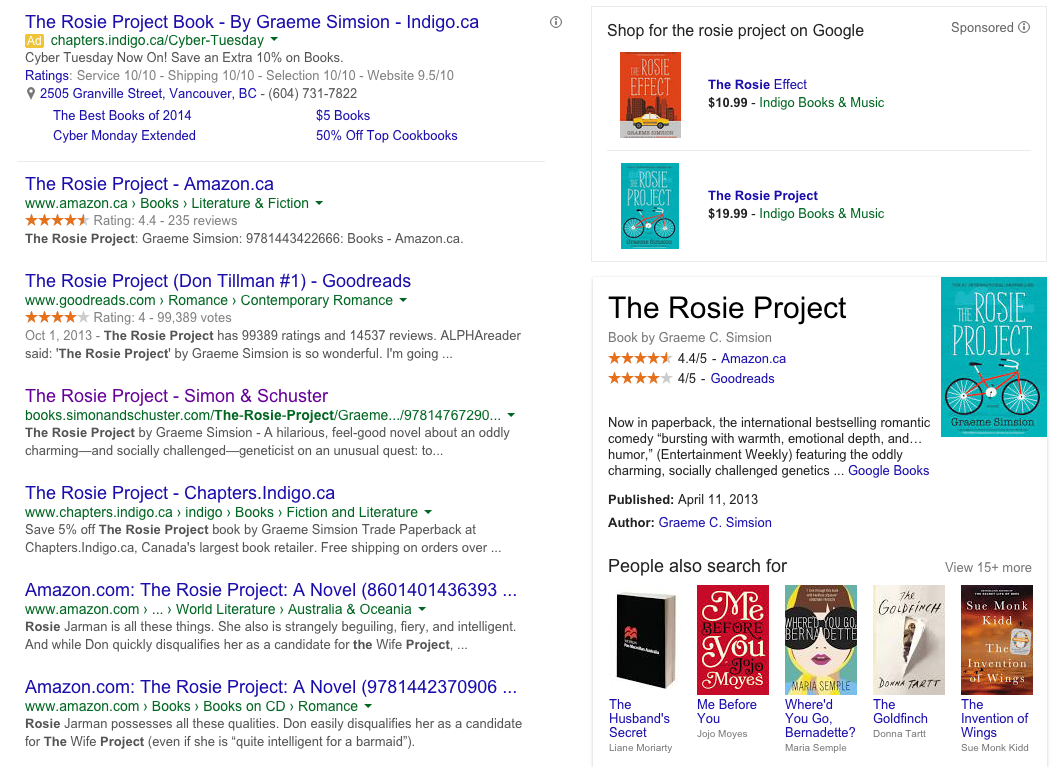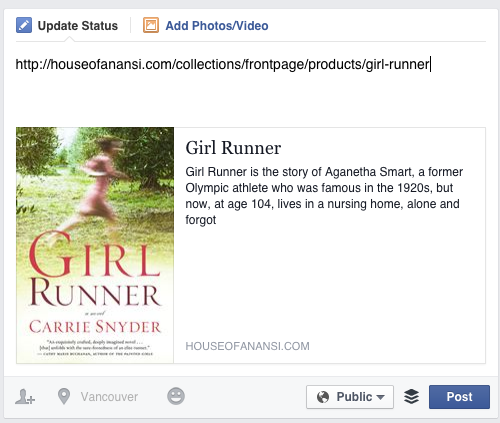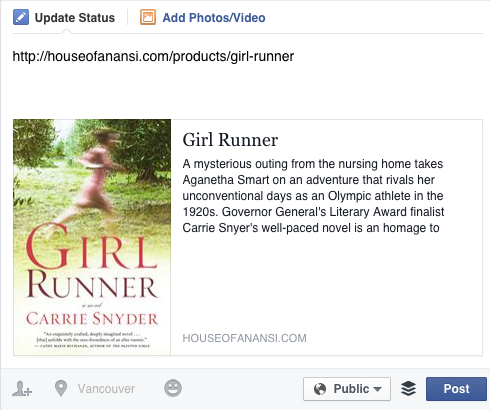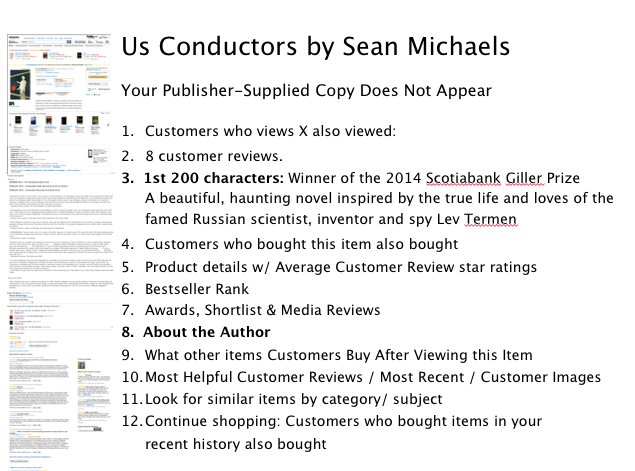The key to book discoverability is not SEO. Instead of mining keyword data, book publishers should optimize 3 crucial aspects of their book marketing. Find out how social sharing, positioning, and reviews lead not just to discoverability but to revenue.
SEO Myths
- SEO is not keyword stuffing. “So this SEO copywriter walks into a bar, grill, pub, public house, Irish bar…” Fail.
- SEO is about ranking #1 in search results. Nope.
The introduction of localization settings, personalized results, and device-specific search results for mobile vs tablet vs desktop mean that the results one person sees is not what another sees. So when the Publisher, Author or Author's Mom says, “I can't find the book,” there are a lot of factors in play, many of which the best marketer cannot control.
What Appears & Why
SEO, when defined as Search Engine Optimization, is a misleading term. The suggestion is that the power is in the hands of the marketer, when really it's in the hands of Google. Google optimizes its results based on what it believes the user wants to see. The Google machine is weighing user intent with most relevant results, it's using user behavioural data and past web page performance, to show on Page 1 the “best of” selection.
Google results for “The Rosie Project”

Google is the shopping mall of results. The big players are dominant, especially when it comes to book searches. What shows up? In order of prominence:
- Retail Channels: Amazon and Indigo appear in both organic listings and sponsored listings, and often in sidebar or top callout sections. These listings are the most visible, even if they are not in the #1 spot, because star ratings and reviews are included.
- Major Marketing Channels: Goodreads (maybe LibraryThing) and YouTube are next. i.e., stuff owned by Google and Amazon. Again the visual aspects of star ratings and video thumbnails help these listings trump the others.
- Publicity Channels: Traditional media reviews (and occasionally blogs if no major reviews are available) round out the results.
Redefining SEO
Well-meaning SEO experts tell book publishers to do keyword research. They offer great tool suggestions. And they make an excellent case for allocating several hours, if not a full day, to crafting each book description. But 1) publishers do not have time and 2) search behaviour related to books is about intent. People are searching for a title, author or comparable title because they have already encountered the book elsewhere. Search is not the discovery mechanism.
BookNet Canada survey data shows that 56% of Canadians become aware of a book online, in particular through ads, email newsletters and reviews; and 48% become aware of a book through in-person activities (recommendations, gifts, book clubs, etc.).
Andrew Rhomberg's five types of book discovery, illustrate how awareness of a book is generated:
- Serendipitous discovery—the random stumbling over a book
- Social discovery—word of mouth and trusted recommendations
- Distributed discovery—discovering books from sources of distribution such as book reviews, conferences, blogs, even at bookstores
- Data-driven discovery—books marketed to readers through data, such as apps or ads personalized based on shopping habits or previous purchases
- Incentivized discovery—book giveaways, contest rewards, promotions, and the like.
What then is SEO for books?
- S for Social and Serendipitous Discovery (sales handles and social sharing capabilities)
- E for External Validation (media and customer reviews)
- O for On-Page Optimization (publisher copy optimized to nudge the sale)
TL;DR | Put your energy into writing a dynamite Sales Handle and getting reviews. The first 40 words of the book description are all that appears on Amazon and Goodreads book pages, and that word count is the same for what gets pulled into Facebook when the URL is shared. Author bio is the only other bit of text to focus on. And, instead of doing keyword research, focus on getting reviews. Media and customer reviews dominate search results and it's this content that is presented on Amazon and Goodreads. If you have time to optimize your own website copy, then add selective reviews to the description. Reviews that answer “is this book any good” are going to generate more sales than any keyword-rich description can.
1. S for Social and Serendipitous Discovery
More specficially, S for Sales Handle and Social Sharing.
Sales Handle: The #1 thing publishers have in their control is how the book is positioned in the market. The sales handle is 25-40 words, basically a 7-second pitch, that answers “what it is, who is it for, and so what?”
Eg sales handle, “WINNER Governor General's Literary Award. An edgy and extravagant YA novel about a glamorous boy named Jude.”
Isn't the sales handle just for the trade?
- Sales reps use the sales handle with booksellers during initial order meetings.
- Booksellers, media, and the author in turn use the sales handle as a sound bite to quickly describe the title.
- And when done well, this repeatable bit of text trickles down to readers who use it as an easy way to describe the book to someone else.
Recommendation: Make the sales handle the first 200 characters of the book description.
3 Reasons to Use the Sales Handle Upfront:
a) When potential readers come across publisher book pages, they should be able to immediately grasp the title. They are only going to read the first bit of the blurb. If the first 200 characters don't interest them, they will not read further.
b) Sharing via social media, in particualr Facebook, is highly visual. When a user shares a URL, only the cover image, title and first 200 words appear. Publishers who employ a sales handle as the first sentence are capitalizing on this type of Social and Serendipitous Discovery. The first 40 words need to function as a standalone description that can sell the book and inspire potential readers to follow the link. “I wonder what that is” does not get the click. “That looks interesting” does.
Eg URL shared in Facebook. The copy does an ok job of describing what the book is about, but it is unclear whether this is fiction or nonfiction.

c) The top retail and marketing sites that dominate search results get far more visitor traffic than any publisher site, which means that most potential readers are not exposed to the publisher-supplied book description. Amazon only shows the first 200 characters of the book description (about 40 words). Goodreads pulls in the first 65 words. Indigo uses100 words. Understanding the cut-off points and using the sales handle as the first sentence ensures that the copy presented is deftly positioning the title in the minds of potential readers.
The first 40 words should answer:
- What is it (be clear on the category, type of book)?
- Who is it for (people who like, do, want x will like this book)?
- So what (awards, author credentials, newsworthy, other selling points)?
Consider this reframing of Girl Runner:
“A mysterious outing from the nursing home takes Aganetha Smart on an adventure that rivals her unconventional days as an Olympic athlete in the 1920s. Governor General's Literary Award finalist Carrie Snyer's well-paced novel is an homage to women who break boundaries.”

Which leads us to …
2. E for External Validation
What other people say about the book is more important than the publisher-supplied book copy.
As noted above traditional media reviews dominate search results, often taking up 5 of 10 first-page listings. But sites like Amazon and Goodreads win people over because their listings include star ratings and reviews. These two giants also heavily display user-generated content for book pages. Only the 1st 40-60 words of the publisher-supplied book description is displayed as well as the author bio.
Deconstruct any Amazon book page and you'll see that social proof or external validation—what other people say about the book—is repeatedly used to generate the sale.
- Star ratings & reviews
- Bestseller rank
- Awards, Nominations
- Media reviews
- Comp titles either purchased or viewed by similar customers
3. O for On-Page Optimization of Your Own Website
If you have time to optimize the book description on the publisher website, then focus on integrating selective reviews or advance blurbs into the copy. Instead of focusing on keyword-rich copy, write text that creates forward momentum and answers for the reader “is this any good, is it worth the cost, will I like it.”
Here's the priority order for book descriptions:
- Sales Handle: What is it, who is it for, what's so great about this book or author?
- Strong quote or advance blurb that answers “is this any good?”
- Punchy description: Themes, hooks, highlights vs. plot synopsis for fiction. Main talking points for nonfiction.
- Answer anything that might be confusing: if it's a revised edition, what's different? If it's nonfiction, is it controversial, a new take on an old topic, what's unique about the book?
- Position and frame the experience: quality of writing, writing style, comparable authors. Basically answer “if you like x, then you'll like this book.”
Get more tips for creating winning book landing pages here.
The Recap
- The 1st 40 words of the book description should be a sales handle.
- The author bio should be used to identify what else the author has written, establish any credentials, and identify comparable authors or writing styles.
- Social sharing is important. Make sure your publisher pages pull in the correct information when the URL is shared online.
Image Source: http://xkcd.com/386/





